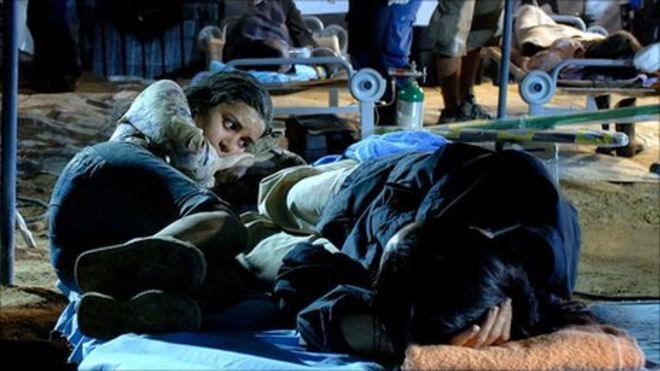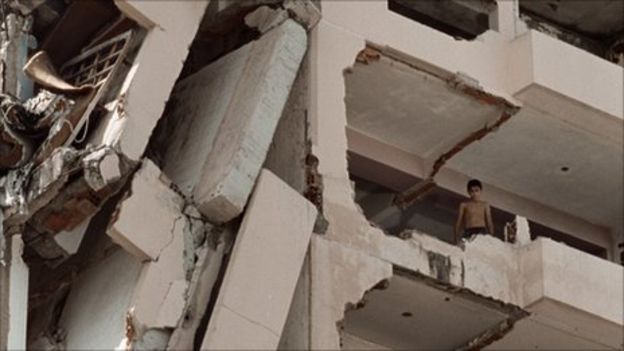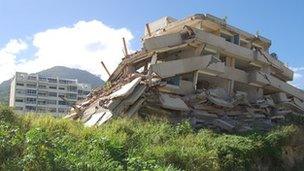-
9 February 2011
 Frank Spano’s film depicts the immediate aftermath of the Vargas disaster
Frank Spano’s film depicts the immediate aftermath of the Vargas disaster
This year sees the release of three different Venezuelan films that touch upon a natural disaster that scarred the country and still resonates to this day.
In 1999, catastrophically heavy rains in the north of the country led to massive landslides which buried whole villages and swept buildings into the Caribbean. Rescue workers estimated the total number killed at between 10,000 and 30,000, but the actual figure remains a mystery.
“I haven’t been back to Vargas since,” says Johnny Gavlovski, a Caracas-based psychologist.
In the immediate aftermath of the tragedy, he and six colleagues were drafted in to help thousands of survivors cope with what they had seen and experienced.
“After everything I found out, everything I heard, all the tears I saw, I couldn’t go back,” he says.
Vargas is one of Venezuela’s 23 states, stretching along the Caribbean coastline to the north of the capital, Caracas.
It is where thousands of city-dwellers from Caracas used to spend their weekends at the beach, but the area was unrecognisable after the disaster.
The landslides changed the landscape of Vargas, with fallen mud and rocks altering the coastline and pushing it dozens of metres further out to sea.
“It hasn’t been dealt with… it’s stayed in many people’s memories and there’s nothing better than art for coming to terms with the collective memory,” Mr Gavlovski says.
The disaster had such a profound effect on Venezuelans that it inspired three different films, all being released in 2011, quite a feat in a country that produces around 10 to 15 feature-length movies a year.
“It’s completely logical and necessary that the most important natural disaster in the country’s history would be a theme we should talk about,” says Alejandro Bellame, director of El Rumor de las Piedras (The Rumble of the Stones).
“I think enough time has passed that has allowed us first to live the tragedy, second to mature and to grieve and then the moment comes to reflect on what happened afterwards.”
His film tells the story of one family and how they are struggling to survive in the slums of Caracas, 10 years after they lost their home in Vargas.

The movie looks at many issues in present-day Venezuela, including violence and poverty.
The motif of house and home, and what it feels like to lose both, is present throughout.
It is a poignant reminder that even so many years later, some of those who had to leave Vargas are still awaiting permanent re-housing.
The collapsed shells of apartment buildings and houses caught up in the landslide still dot the coastal towns affected.
And as the country has recently experienced more heavy rain, thousands of newly homeless families are also seeking shelter, exacerbating the country’s housing shortage.
Frank Spano’s Hora Menos (One Hour Less) takes the viewer in a completely different direction.
Set in the immediate aftermath of the tragedy it is the tale of two women – from different backgrounds, different generations, different social classes – who are brought together by the loss of their homes. They travel together to the Canary Islands to start a new life in Europe.
“The journey allows these two women to find out who they really are, and I think a tragedy of this magnitude obliges us to think about who we are,” says Spano.

Destroyed buildings dot the landscape of Vargas
“It’s saying to the viewer… that a whole life full of money and material possessions can be buried by the mud but what stays with us is our capacity for tolerance and our ability to relate to each other.”
The third movie, El Chico que Miente (The Kid who Lies), came out in Venezuelan cinemas on 28 January.
It is the story of a boy who loses his home in the landslides and 10 years on, he sets out to find out the truth about what happened to his family during the tragedy.
It has been produced and directed by Mariana Rondon and Marite Ugas, the same team behind Postcards from Leningrad, Venezuela’s official entry for best foreign language film at the Academy Awards three years ago.
“This is not about a natural disaster. This is about what transformed a society, and that happened in Vargas,” says Ugas.
The film is not political, but Ugas sees significance in the timing of the tragedy and Venezuela’s recent political history.
The landslides occurred almost exactly one year after President Hugo Chavez first won elections and just as he held a referendum to approve a new constitution.
“[The elections] turned the country into two different camps and for some it began a new era of socialism and for others it was like a tragedy,” Ugas explains.
“The film invites people to reflect on the last 10 years.”
Fuente: http://www.bbc.com/